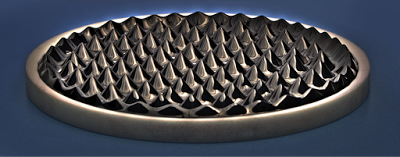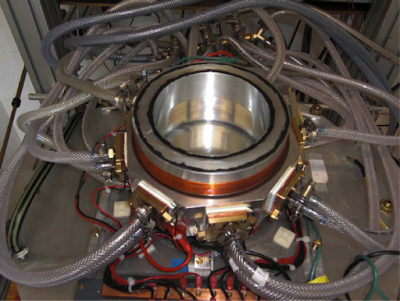What do physicists do when they get stuck on a problem? In the case of
magnet mountain growth rates, they chill and stick with it.
Under the right kind of magnetic field, a dish of magnetic liquid,
called ferrofluid, will grow mountains. Scientists have been studying
this fascinating process for fifty years. This spring, a collaboration
from Bayreuth University and Dresden Institute of Technology opened up a
new area of study on the subject by using a thick, sticky, honey-like
magnetic liquid.
 |
| Magnetic "mountains". The container has a diameter of 120 mm. Image Credit: Achim Beetz, Univ. Bayreuth |
Initially developed by NASA as a possible way to control rocket fuel in zero gravity, ferrofluids are used today in applications ranging from audio loudspeakers to vacuum seals and therapeutic drug delivery systems because of their unique properties. Ferrofluids have also led to new insights in the study of pattern formation, important for understanding many aspects of how nature works.
In order to form magnetic mountains, the ferrofluid needs to be in a magnetic field above a certain critical strength. At that point, something called a Rosensweig instability manifests and the mountains begin to grow. Ronald Rosensweig led the technical development on magnetic liquids in the 1960s and coined the term ferrofluid.
The term growth rate describes how the height of these mountains change as they form. In 2001 Adrian Lange (now at Dresden Institute of Technology) predicted that the growth rate would vary with the strength of the magnetic field in two ways:
• For magnetic field strengths between the critical strength and a boundary strength, the growth rate would have a linear dependence on the magnetic field. This means a magnetic field three times as strong would lead to a growth rates three times as high.
• For higher magnetic fields, the growth rate would depend on the square root of the magnetic field. This means a magnetic field three times as strong would lead to a growth rate proportional to the square root of 3 (about 1.7).
For a regular ferrofluid, there is only a tiny range of magnetic field strengths during which the linear dependence would happen. It’s so small that Lange and his longtime friend Reinhard Richter (Bayreuth University) thought it would never be verified by an experiment, a “purely academic result” according to Richter.
The growth rate in the second case, with a higher magnetic field, was measured and matches the theory. This was announced in 2007 by Lange, Richter, and their collaborators. However, they remained stuck on experimentally verifying the first case.
This brings us to the honey.
As a PhD student of Richter’s, Christian Gollwitzer developed a special octagonal cooler, nicknamed “octopussy”, for another experiment. Not long after, he and Richter realized that octopussy could tackle the seemingly impossible experimental question of the linear relationship too.
 |
| "Octopussy". The diameter of the inner circle is 140 mm. Image Credit: Tobias Lang |
Using honey-like ferrofluid had two experimental advantages. First, the long time scale enabled them to measure the pattern formation with an x-ray imaging technique that takes longer, but collects more detailed information than the technique used with regular ferrofluids. Second, they were able to significantly expand the range of magnetic field strengths between the critical strength and the boundary strength. This is because the value of the boundary strength, the magnetic field strength that separates the linear dependence from the square root dependence, increases with the viscosity of the fluid.
 |
| A sketch of the x-ray imaging technique. Image Credit: Reinhard Richter |
“Using 'magnetic honey' we created a kind of upside-down version of the pitch-drop experiment. This gives us many advantages for future research in pattern formation” said Richter. He invites postdocs and graduate students to come to the lab and join in the fun.
—Kendra Redmond










No comments:
Post a Comment